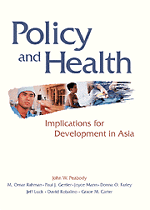Book contents
- Frontmatter
- Foreword
- Preface
- Contents
- Tables
- Figures
- Boxes
- Chapter One OVERVIEW: THE ROLE AND RESPONSIBILITY OF GOVERNMENTS IN THE HEALTH SECTOR
- Chapter Two EVIDENCE-BASED POLICY: USING DATA TO INFORM POLICY AND IMPROVE HEALTH OUTCOMES
- Chapter Three PRIORITIZING MEDICAL INTERVENTIONS: DEFINING BURDEN OF DISEASE AND COST-EFFECTIVE INTERVENTIONS IN THE PURSUIT OF UNIVERSAL PRIMARY CARE
- Chapter Four FINANCING AND ALLOCATING PUBLIC EXPENDITURES: LEVERAGING PUBLIC RESOURCES TO MEET OBJECTIVES AND INCREASE PRIVATE PARTICIPATION
- Chapter Five TOWARD BETTER EQUITY AND ACCESS: PERSISTENT POVERTY, INADEQUATE INTERVENTIONS, AND THE NEED FOR BETTER DATA AND SOLUTIONS
- Chapter Six GOVERNMENT AND THE IMPROVEMENT OF HEALTH BEHAVIORS
- Chapter Seven IMPLEMENTING POLICY OBJECTIVES: THE ROLE AND RESPONSIBILITIES OF THE MINISTRY OF HEALTH
- Acronyms
- Data Notes and Glossary—Chapter Two
- References
- Authors
- Index
- Plate section
Chapter Three - PRIORITIZING MEDICAL INTERVENTIONS: DEFINING BURDEN OF DISEASE AND COST-EFFECTIVE INTERVENTIONS IN THE PURSUIT OF UNIVERSAL PRIMARY CARE
Published online by Cambridge University Press: 18 December 2009
- Frontmatter
- Foreword
- Preface
- Contents
- Tables
- Figures
- Boxes
- Chapter One OVERVIEW: THE ROLE AND RESPONSIBILITY OF GOVERNMENTS IN THE HEALTH SECTOR
- Chapter Two EVIDENCE-BASED POLICY: USING DATA TO INFORM POLICY AND IMPROVE HEALTH OUTCOMES
- Chapter Three PRIORITIZING MEDICAL INTERVENTIONS: DEFINING BURDEN OF DISEASE AND COST-EFFECTIVE INTERVENTIONS IN THE PURSUIT OF UNIVERSAL PRIMARY CARE
- Chapter Four FINANCING AND ALLOCATING PUBLIC EXPENDITURES: LEVERAGING PUBLIC RESOURCES TO MEET OBJECTIVES AND INCREASE PRIVATE PARTICIPATION
- Chapter Five TOWARD BETTER EQUITY AND ACCESS: PERSISTENT POVERTY, INADEQUATE INTERVENTIONS, AND THE NEED FOR BETTER DATA AND SOLUTIONS
- Chapter Six GOVERNMENT AND THE IMPROVEMENT OF HEALTH BEHAVIORS
- Chapter Seven IMPLEMENTING POLICY OBJECTIVES: THE ROLE AND RESPONSIBILITIES OF THE MINISTRY OF HEALTH
- Acronyms
- Data Notes and Glossary—Chapter Two
- References
- Authors
- Index
- Plate section
Summary
OVERVIEW
Prior to 1940, many people argued that medicine offered little to improve health or prolong life. However, since the discovery of sulfonamides in the mid-1930s, a panoply of medications, surgeries, and preventive measures have contributed enormously to human well-being, with new interventions and better therapies being developed every year. Just as important, there is a better understanding of the complex interactions between disease and the environment, between health and economics, and between social development and collective welfare.
Today, scientific investigations have shown that some therapies are effective, safe, and in many cases affordable to even the poorest of individuals. Other therapies are effective but are more expensive and, thus, require careful balancing of the costs and benefits, which vary with location, culture, and social structure. Still others are less efficacious but still are provided in place of more efficacious, better substantiated, and less-expensive interventions.
Choosing the right set of interventions is therefore an increasingly complex task of public policy. In some cases, the evidence for therapies is so overwhelming that all governments should try to make these interventions available as widely as possible; in other cases, the evidence is conflicting or, more commonly, incomplete. Thus, decisions are much harder to make and governments must be more cautious. In addition, whatever choices governments make are inevitably constrained by resources. And what makes choosing among interventions even more complex is that these choices have life-and-death consequences.
- Type
- Chapter
- Information
- Policy and HealthImplications for Development in Asia, pp. 74 - 133Publisher: Cambridge University PressPrint publication year: 1999

